The Best Running Shoes of 2023: We Tested Dozens of Pairs to Find Our Favorites
For the average runner, choosing the best running shoes is a daunting task. There’s an overwhelming number of options on the market, and even for experienced athletes, it can be difficult to know which shoe models will best suit your running style, gait, and the terrain you run on. To help you sort through the footwear deluge, the Men’s Journal staff and I put dozens of running shoes to the test and highlighted our favorites in this guide.
Men’s Journal aims to feature only the best products and services. We update when possible, but deals expire and prices can change. If you buy something via one of our links, we may earn a commission.
Best Overall: Saucony Endorphin Speed 3
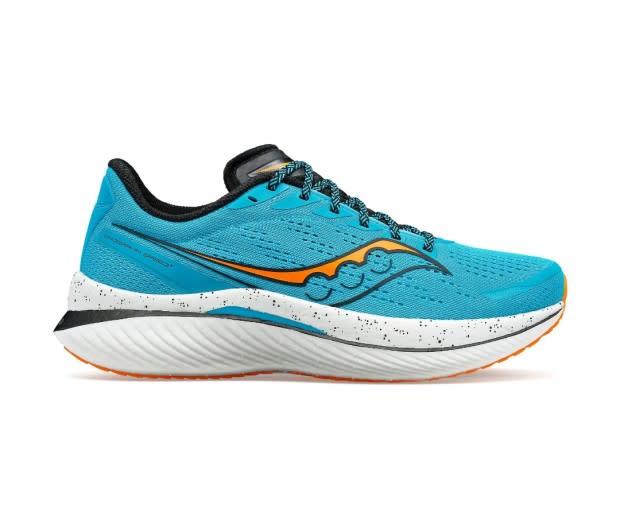
Courtesy Image
Need one shoe that can do it all? The Saucony Endorphin Speed 3 comes as close to achieving that goal as any shoe we tested this year. At just 8.1 ounces, it’s as light as many of the best racing shoes, and the Pwrrun PB midsole feels incredibly springy underfoot. This midsole is made with polyether block amide (PEBA) foam, a very soft, lightweight, and highly responsive compound used in many brands’ premium running shoes. The Pwrrun PB material gives the Speed 3 a noticeably peppy ride with excellent shock absorption, too.
The Speed 3 also features a rocker sole shape (where the sole curves upward at the toe and heel) and a nylon plate embedded within the midsole. The rocker shape promotes smooth, efficient transitions from landing to toe-off, and the stiff midsole plate flexes at landing and snaps back into shape for an extra boost of energy return. These features make the shoe well-suited to fast paces, but it also has plenty of cushioning for running long distances—it fared well for me on a 9 mile Sunday long run, for example. In my testing, I also appreciated the breathable upper, which kept my feet comfortable in summertime Arizona heat (I live in Phoenix).
The only drawbacks? The exposed midsole areas showed wear quickly (PEBA isn’t a super durable material), and the Speed 3 runs small. I had to go up a whole size to give my toes enough wiggle room.
Weight: 8.1 oz
Drop: 8mm
Pros | Cons |
|---|---|
Lightweight | Runs small |
Springy and fast | Exposed midsole areas lack durability |
Suitable for racing and training | |
Well-cushioned and comfortable |
[$170; amazon.com]
How We Tested and Selected the Best Running Shoes of 2023
I worked with Men’s Journal editors and a team of wear testers—ranging from dedicated marathoner racers to fitness runners—to try as many top running shoes as possible. We called in test pairs and organized the shoes into 12 categories representing various running disciplines and runner preferences, including racing shoes, trail shoes, and shoes for wide feet. We ran in each shoe and evaluated it for key traits like fit and comfort, midsole cushioning, weight, and overall value. We took notes on our testing experiences and used those impressions to choose the shoes that made it into this guide.
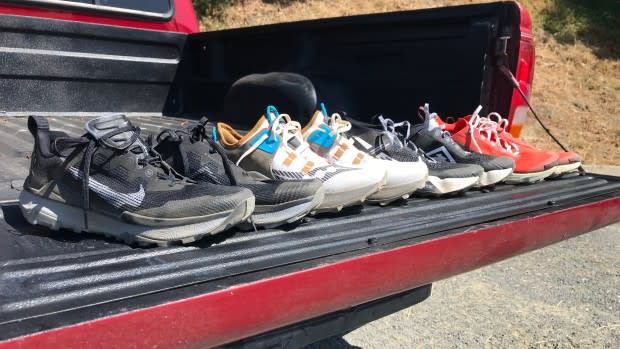
Michael Charboneau
What to Consider When Shopping for Running Shoes
There are a few key factors to keep in mind when searching for and comparing running shoes.
Fit and Comfort
Fit and comfort are arguably the most important factors in any running shoe, and they’re also the hardest to assess when shopping online. Dr. Paul Nasri, a New York-based physical therapist with years of experience working with runners, recommends shopping the old fashioned way: Going to a running store. There, you can get your feet sized and try out shoes to determine what pair feels right for you.
“You should walk and run on the treadmill to make sure you feel comfortable in that sneaker,” Nasri tells Men’s Journal.
How You Run
In addition to choosing a shoe that feels comfortable, make sure it’s designed for the kind of running you like to do.
Speed Training and Racing: Runners who are focused on speed will benefit from lightweight, responsive shoes that feel bouncy and propulsive underfoot. The Adidas Adizero Boston 12 is a great example of this kind of shoe: It features a midsole design that’s optimized for a snappy feel with lots of energy return, which helps you maintain faster paces.
Everyday Running: For day-to-day training, look for shoes that are durable, cushioned, and supportive. Because you’ll put a lot of miles on these pairs, focus on options with rubber outsoles that cover most of the bottom of the shoe—they’ll last longer and provide better traction, too. While the exact amount of midsole cushioning is a matter of personal preference, most runners prefer a well-cushioned shoe for their everyday trainer, as it absorbs impact forces and feels comfortable.
Support features can also be helpful in a daily trainer, especially for runners who overpronate (their feet roll inward between landing and toe-off). Although Nasri cautions that some inward rolling, or pronation, is a normal part of running, many runners appreciate shoes that counteract this motion. The Asics GT-1000 and Hoka Gaviota 4 below both have midsoles with firmer foam layers designed for support: They cradle the feet and bolster your arches to keep your feet aligned in the shoe as you run.
Long-distance Running: Everyday training shoes can work fine for longer runs, but you can also consider shoes with even more cushioning and support—they’ll create a soft, comfortable ride and promote good form, even when your legs get tired. The Asics NovaBlast 3 is our pick for a max-cushion shoe, and it’s ideal for long runs: Although it lacks support features, it provides excellent shock absorption and a responsive ride to keep you going through high-mileage efforts.
Trail Running: Do you mainly run on trails? You’ll need trail shoes. These models are designed for off-pavement running, and they feature durable rubber outsoles with lugs (small, cleat-like protrusions) that dig into soft ground and generate traction in the dirt. The Nike Pegasus Trail 4 GTX, our pick for the best trail shoe, offers a grippy lugged outsole and a cushioned-yet-responsive ride, and it also has a water-resistant upper to keep your feet dry in wet weather. For even more off-road options, browse the Men’s Journal trail shoes guide.
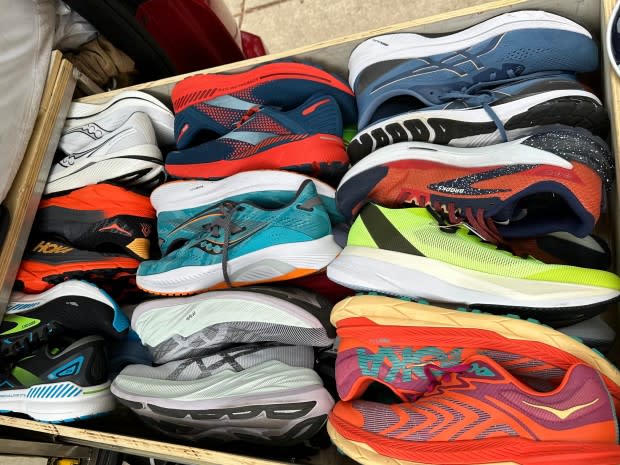
Nathan Lemin
Key Specs: Weight and Drop
We’ve included the weight and drop measurements for each shoe in this guide. Drop refers to the difference in height between the heel and the forefoot along the footbed of the shoe—the higher the drop, the steeper the slope from heel to toe within the shoe. The amount of drop affects how the forces of running are dispersed across your legs: High-drop shoes (8mm or more) put more load on your knees, while low-drop shoes (4mm or less) shift the load to your ankles and calves.
Lighter shoes are generally better suited to speedwork and faster paces, and heavier shoes usually offer more cushioning, durability, and support. There’s no right or wrong amount of drop; it’s purely a matter of what feels comfortable on your feet. These specs can help you compare models, but the most important thing is to choose a shoe that suits your needs and running style.
Below, we’ve vetted and selected the best running shoes across 12 major categories, including picks from top brands like Saucony, Asics, and more.The Best Men's Running Shoes of 2023
The Best Men's Running Shoes of 2023
Best Everyday Trainer: Brooks Ghost 15
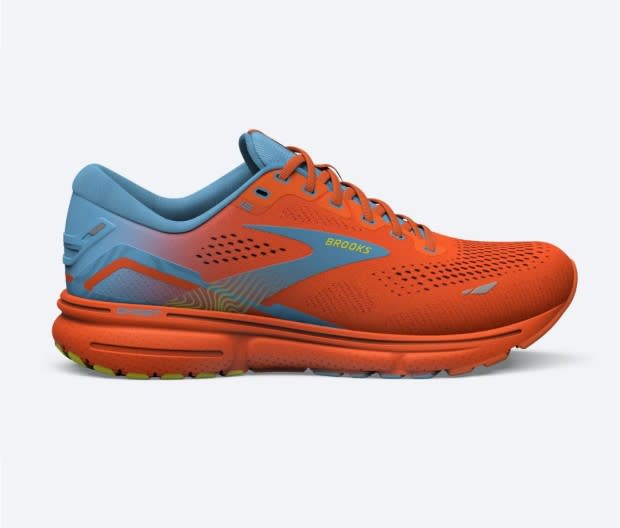
Courtesy Image
Every runner needs a reliable workhorse training shoe. I love the Brooks Ghost 15 for my casual runs when mile splits aren’t important and enjoying time outside is the main goal. The Ghost has long been popular (hence its 15 iterations) for its comfortable ride and great fit. The midsole foam is soft and provides good shock absorption, and the upper is both breathable and flexible while providing a reliably snug fit. That’s true even if you have wide or narrow feet, as these shoes are available in four different widths (1B through 4E).
Because the Ghost prioritizes comfort and fit over speed, the shoe is a bit heavier and less springy than other picks. Additionally, the high heel-toe drop (12mm) may not work for runners who prefer a lower-drop footbed. But if you need a durable everyday shoe that serves up a comfy, cushioned ride, the Ghost is a great choice.
Weight: 10.1 oz
Drop: 12mm
Pros | Cons |
|---|---|
Soft, well-cushioned ride | Somewhat heavy |
Available in a variety of widths | Not very responsive |
[$140; amazon.com]
Best Value: Asics GT-1000 12
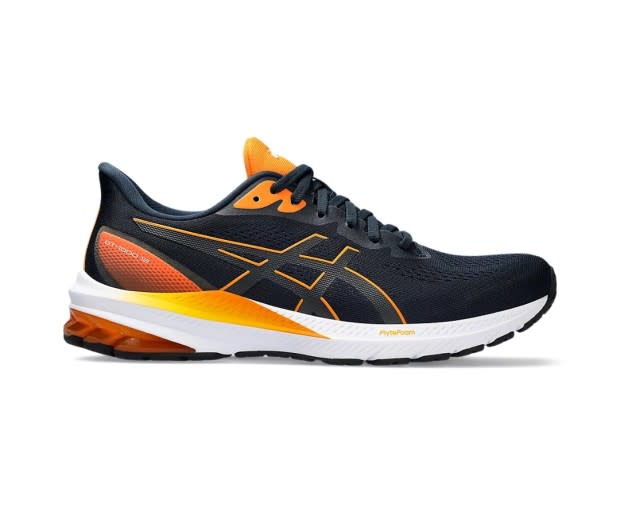
Courtesy Image
For over a decade, the Asics GT-1000 has been a top affordable running shoe, and the 12th iteration continues that legacy. I found this shoe to be super comfortable—similar to the Ghost but softer and more flexible. I frequently run in hot weather, and I love that the lightweight and breathable upper keeps my feet cool. (Some runners might want an upper with a little more rigidity and support, however.) I overpronate slightly when running, and I appreciated the shoe’s LiteTruss midsole design: A firmer layer of foam on the medial side supports the foot and keeps it from rolling too far inward.
Overall, I found the Asics GT-1000 12 offered the performance benefits of other everyday trainers—soft cushioning, a comfortable ride, and a secure fit—for about $50 less. The savings make this a great option for beginners or anyone who needs an affordable training shoe for the pavement.
Weight: 9.4 oz
Drop: 8mm
Pros | Cons |
|---|---|
Great value | Sole might be too flexible for some |
Comfortable ride | Lightweight upper lacks structure |
[$100; amazon.com]
Best Trail Shoe: Nike Pegasus Trail 4 GTX
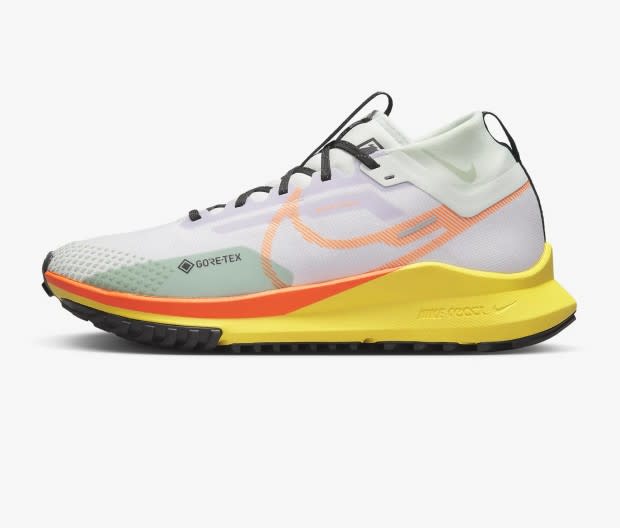
Courtesy Image
The Nike Pegasus Trail 4 GTX earned its status as our favorite trail shoe because it tackles a variety of terrains really well. Men’s Journal editor Michael Charboneau tested this shoe, and he loved the React midsole foam: It hit a perfect balance of shock absorption and bouncy responsiveness. In both wet and dry conditions, the shoe created confidence-inspiring grip on hard-packed trails, rock, and even pavement. The Gore-Tex liner kept his feet warm and dry through light rain, and the flexible upper created a close fit without slippage. If you run on primarily dry trails or in hot weather, however, these aren’t the best pick—the Gore-Tex upper reduces the shoe’s breathability. Check out our trail running shoes guide for even more options.
Weight: 10.2 oz
Drop: 9.5mm
Pros | Cons |
|---|---|
Good traction on varied terrain | Upper lacks breathability |
Great for wet weather | |
Well-balanced cushioning |
[$160; amazon.com]
Best Road-to-Trail Shoe: Hoka Challenger 7
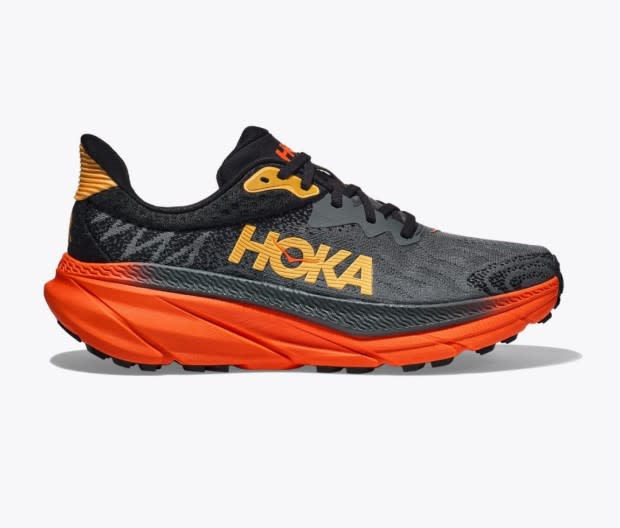
Courtesy Image
I might be this shoe’s biggest fanboy: I’ve worn the last three iterations of the Hoka Challenger, and the seventh version is an excellent follow-up. A hybrid shoe has the tough task of working well on both the road and the trail. The shoe needs lugs to dig into dirt and create traction, but the lugs can’t be too big or rigid, otherwise the shoe will feel unstable and uncomfortable on pavement. The Challenger achieves this balance with moderate 4mm lugs at the forefoot and heel for off-road traction and significant outsole voids at midfoot to maintain flexibility for the road.
This Challenger 7’s midsole was supportive enough to keep me poised on technical terrain, but it also felt pliable and comfortable on hard, flat surfaces. And while this isn’t the most cushioned model in the Hoka lineup, it provides enough shock absorption for a comfortable ride on all terrain types. My favorite part about the Challenger 7 is the new upper. It’s made from a soft mesh that’s stretchy enough to move with the foot, and it also holds its shape to maintain a close fit. On the run, the shoe did a great job of locking in my feet, especially at the heel. The upper has a rigid heel counter that firmly hugged even a narrow heel shape like mine.
The only weak point on the Challenger 7 is the exposed midsole foam under the arch: It’s not covered with outsole rubber, and it got a bit chewed up on rocks and rough trails in my testing. But for mixed-terrain runs and light trail running, this is an excellent option.
Weight: 8.9 oz
Drop: 5mm
Pros | Cons |
|---|---|
Comfortable on both road and trail | Exposed midsole area prone to damage on rocky trails |
Secure fit and good breathability |
[$145; amazon.com]
Best Shoe for Wide Feet: Brooks Adrenaline GTS 23
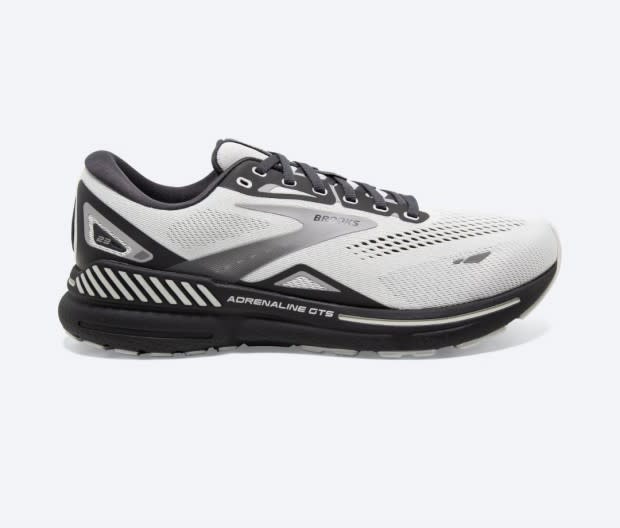
Courtesy Image
The Adrenaline is a standout model for wide-footed runners in search of a proper fit. To test this shoe, I worked with my uncle and cousin, both of whom have boxy, wide feet. My cousin recently converted to the Brooks Adrenaline GTS 22. My uncle tried the updated 23.
Often, folks with wide feet must settle for one of two extremes: either wearing shoes that are too narrow and constrict their feet, or wearing shoes that are the correct width but don’t keep their feet secure within the shoe. The Adrenaline solves both issues. The shoe is available in wide (2E) and extra-wide (4E) sizes, so you can get plenty of space no matter the shape of your foot. It’s also equipped with Brooks’ GuideRails, which are firmer layers of foam placed around the heel and the medial side of the footbed. The GuideRails cradle your feet, countering overpronation and keeping them aligned in the shoe—even if you opt for the extra-wide sizes. Testers loved the shoe’s wide toe box and very stable feel; they also appreciated its flexibility and secure fit. My uncle was shocked to discover he could fit into the Adrenaline without using specialized lacing techniques—something he often has to do with other shoes. The Adrenaline has the same soft cushioning as the Ghost above, and it’s a great everyday trainer for wide-footed runners.
Weight: 10.1 oz
Drop: 12mm
Pros | Cons |
|---|---|
Available in wide and extra-wide sizes | High drop may be uncomfortable for some runners |
Very stable ride |
[$140; amazon.com]
Best Shoe for Bigger Runners: Saucony Guide 16
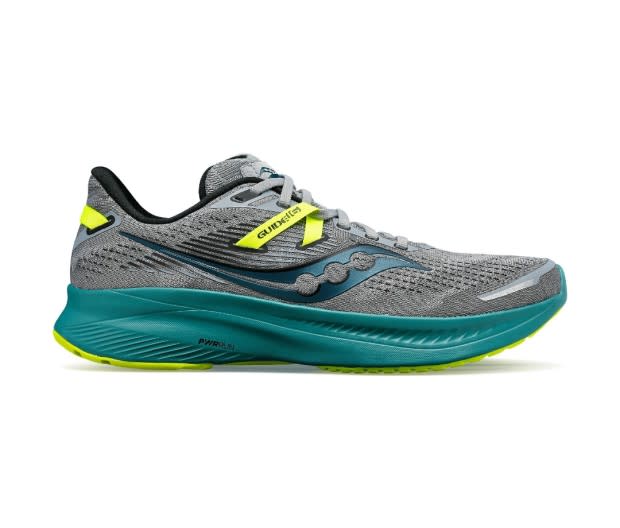
Courtesy Image
Finding the best running shoes for heavy men can be challenging: The industry tends to neglect runners who don’t look like world-record holders. To find the best shoe in this category, I enlisted the help of three runners who weigh over 240 pounds and had them try out a few different models. The Guide 16 was their clear favorite.
While the Guide is a great choice for a variety of runners (it happens to be one of my favorites on this list), there are a few aspects that make it the best running shoe for big men. First, the sole is notably wide in the heel and forefoot. The testers appreciated this design, as it improved the shoe’s balance and stability. Additionally, all the testers loved the Pwrrun cushioning: They reported that it felt very soft, especially at the heel, but it didn’t bottom out, and it felt firm enough to hold up to heavier steps. Finally, the Guide 16 is available in wide sizes, so if you have bigger feet, you can get a version that’ll fit.
These shoes are very lightweight and pretty flexible. Some bigger runners might prefer a more rigid shoe—if that’s you, consider the Adrenaline GTS above.
Weight: 8.8 oz
Drop: 8mm
Pros | Cons |
|---|---|
Planted, secure feel | Flexible sole could feel unstable to some runners |
Lightweight | |
Comfortable cushioning |
[$140; amazon.com]
Best Speed Training Shoe: Adidas Adizero Boston 12
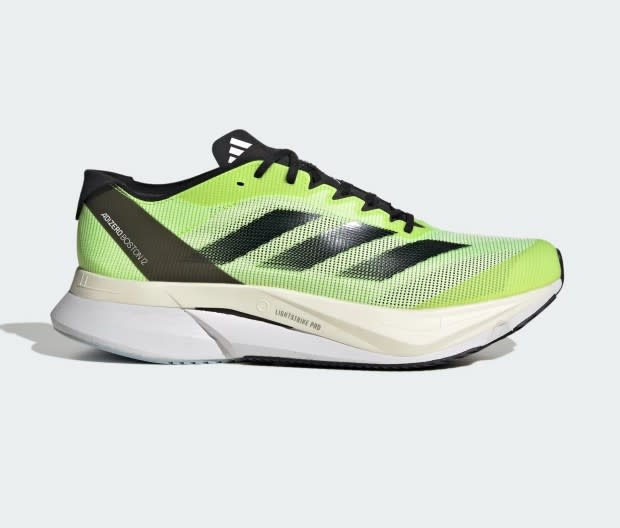
Courtesy Image
The Adidas Adizero Boston 12 checks all the boxes for a speed training shoe. It’s made with the same Lightstrike Pro midsole cushioning as the Adidas Adizero Adios Pro 3, our top pick for racing, and the foam generates ample shock absorption with lots of bounce. The Boston also features EnergyRods, flexible carbon-infused rods embedded in the midsole that align with the metatarsal bones in your foot. The rods bend at landing and then straighten at toe-off, adding a boost of energy return into your stride. Compared to the Adios Pro 3, the Boston has more cushioning (it has an extra layer of Lightstrike 2.0 foam in addition to the Lightstrike Pro material) and a little more outsole rubber for enhanced durability—essential for holding up through a rigorous training plan.
I’m training for a marathon in December, and this shoe has felt great on my mid-distance fast-pace runs. It fits well, the sole feels cushioned and somewhat supportive, and it’s also flexible, so the shoe doesn’t interfere with my natural stride. Overall, the Boston is a great training counterpart to the Adios Pro 3: The two shoes have a similar fit and feel, so it won’t be a big shock when I lace up the Adios on race day.
Weight: 9.5 oz
Drop: 7mm
Pros | Cons |
|---|---|
Comfortable cushioning | Somewhat heavy for a speed shoe |
Excellent energy return |
[$160; amazon.com]
Best Shoe for Flat Feet: Altra Paradigm 7
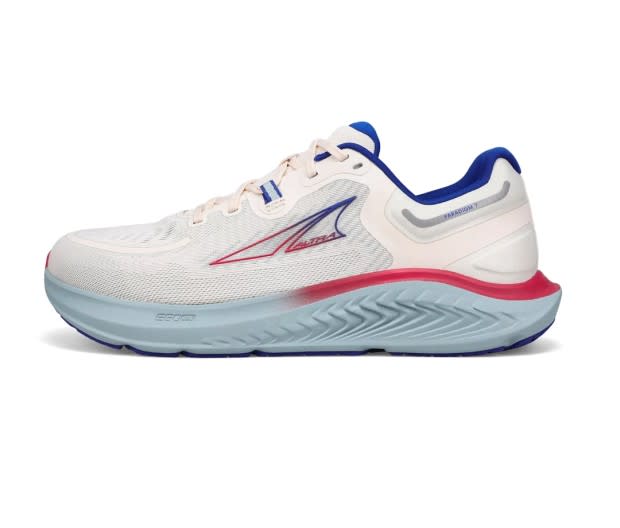
Courtesy Image
The Paradigm 7 is a well-cushioned shoe with a spacious footbed and built-in support, and it’s a strong choice for those with flat feet or collapsed arches. It utilizes Altra’s signature Balanced Cushioning design: The heel and forefoot are at the same height within the shoe, otherwise known as zero drop. When running, zero-drop shoes shift the load away from your knees to your ankles and calf muscles, so these designs can benefit flat-footed runners who suffer from knee pain. The flat footbed is a matter of preference—you’ll have to try these on to see if they work for you—but the Paradigm has other features that work well for flat feet, too.
Anyone familiar with Altras has probably noticed the shoes have a “weird looking toe box,” as one tester put it. The Paradigm looks a little squared off and boxy at the front, but testers found it fit much better than expected, with no looseness, and it gave their toes plenty of room to splay. In addition to a spacious toe box, the shoe has a generous midfoot area that won’t constrict flat feet, and it’s available in wide sizes for even more room. The Paradigm has a relatively thick layer of midsole cushioning for a comfortable ride, and it’s also built with Altra’s GuideRail, a layer of foam on the medial side of the shoe that supports the foot and keeps it properly aligned within the shoe.
If you haven’t tried zero-drop shoes before, stick to short runs at first and give your body time to adjust. And even if you don’t have flat feet, these shoes can be beneficial: I’ve noticed Altras can ease hot spots on my feet that develop after wearing higher-drop shoes.
Weight: 10.4 oz
Drop: 0mm
Pros | Cons |
|---|---|
Excellent fit for flat feet (and wider feet) | Zero-drop design can feel uncomfortable to some |
Stable, well-cushioned ride |
[$170; amazon.com]
Best Running Shoe for Racing: Adidas Adizero Adios Pro 3
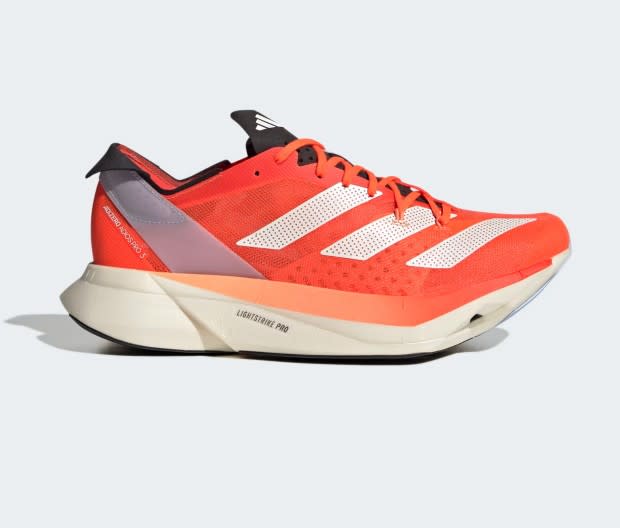
Courtesy Image
The Adizero Adios Pro 3 was a favorite among our testers, and it edged out other popular racers like the Saucony Endorphin Elite. Like many dedicated racing shoes, the Adios Pro 3 looks futuristic and fast: The thick sole has noticeable voids along the outer edge of the forefoot and under the arch to save weight. When running fast (I was shooting for a mid-six minute mile pace), the shoe’s rocker sole shape helped me roll forward smoothly and push hard at toe-off for maximum speed. The thick midsole has lots of bouncy Lightstrike Pro foam paired with embedded EnergyRods (flexible rods that bend during landing and snap back into shape for added energy return). This midsole tech makes the Adios Pro 3 “very aggressive and snappy with a surprisingly soft landing, even at very fast paces,” as one tester described it. Many premium racing shoes have very minimal outsoles—this saves weight while sacrificing grip and durability. But the Adios has lots of outsole rubber, and testers appreciated the shoe’s excellent grip, even in wet weather.
The cutouts on the sole and the shoe’s tall stack height do create some instability, and testers reported a bit of wobbly feel. The Adios also isn’t the lightest racing shoe on the market (the Endorphin Elite and Hoka Rocket X2 are lighter). Even so, this model offered the best combination of a secure fit, comfortable cushioning, and a speedy ride among the racing shoes we tested.
Weight: 8.4 oz
Drop: 6.5mm
Pros | Cons |
|---|---|
Excellent fit for such a lightweight upper | Somewhat wobbly feel |
Sole design promotes speedy transitions | Laces are very short and hard to tie |
Rigid EnergyRods contribute noticeable bounce |
[$250; amazon.com]
Best Stability Shoe: Hoka Gaviota 4

Courtesy Image
While I can definitely get away with neutral shoes, a stability shoe designed to correct overpronation helps my stride, especially during everyday runs and longer efforts. While Hoka pushes the Arahi as its primary stability shoe, I found the Gaviota 4 to be my favorite stability-focused option from any brand.
The Gaviota 4 has a midsole setup similar to the Bondi, Hoka’s popular max-cushion model. This means the Gaviota has lots of plush cushioning (and a correspondingly high weight). Unlike the Bondi, the Gaviota includes Hoka’s J-Frame—essentially, a layer of firmer foam within the midsole that cradles the heel and supports the medial side of the foot. In my testing, I liked the Gaviota’s wide sole geometry, which created a planted feel despite the shoe’s tall stack, and the J-Frame effectively prevented my feet from rolling too far inward. In addition, the rocker sole shape made transitions smooth and easy. While it’s definitely a heavy shoe, the Gaviota excels at longer, slower recovery runs, and it’s a strong choice for overpronators.
Weight: 11.4 oz
Drop: 5mm
Pros | Cons |
|---|---|
Very stable ride | Heavy |
Comfortable feel |
[$190; amazon.com]
Best Max-Cushion Shoe: Asics NovaBlast 3
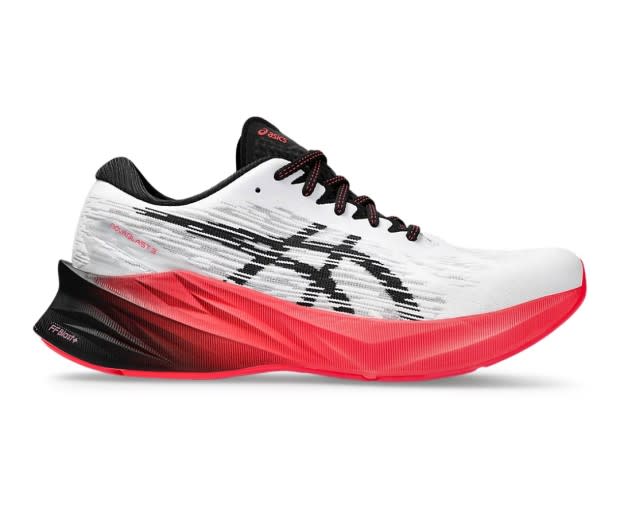
Courtesy Image
Max-cushion running shoes are a great choice for many scenarios, from recovery runs to helping older runners stay in the game. The Asics NovaBlast 3 takes a great platform and upgrades some key features to make it our team’s favorite max-cushion shoe.
For the third iteration of the NovaBlast, Asics used its FlyteFoam Blast Plus cushioning in the midsole, and it’s an upgrade in nearly every way: These shoes are more responsive, lighter, and softer than the outgoing model. Underfoot, I loved how squishy this shoe felt—plush and comfortable but also springy and responsive. It softened my landings and provided plenty of energy return for peppy toe-offs. The upper fits like a really flexible sock. It’s very comfortable, but I did have some difficulty securing it to my feet without slipping. I also experienced some slight overpronation when wearing this shoe, so overpronators will likely need a more supportive option. Even so, the NovaBlast’s plush-yet-propulsive ride and low weight make it a compelling max-cushion offering.
Weight: 8.9 oz
Drop: 8mm
Pros | Cons |
|---|---|
New midsole foam is more comfortable | Insecure fit |
Lightweight for a max-cushion shoe | Not great for stability |
[$145; amazon.com]



